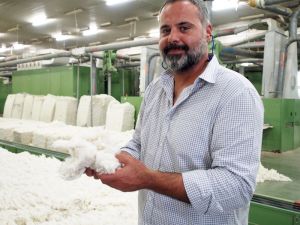Our cotton yarn spinning mill, one of Turkey’s 350 mills, is located in midst of cotton fields. Nur and Sedat welcomed me very warmly and showed me around. On the way to the storage halls, we walked by a group of factory workers, men and women, enjoying their break outside the building, in the shadow of some trees.
Our cotton was bought at the Izmir Commodity Exchange. Two main regional products are negotiated there: cotton and raisins, often grown by the same farmers. Sellers and buyers meet every day from 12am to 1pm to negotiate the daily price face to face. The company that spun the yarn for the first piece of Misogi Dogi fabric is also specialised in trading both cotton and sultana raisins.

The ginned cotton is stored in large halls. Quality and origin is marked on each bale: the mill spins 20% organic cotton, 80% conventional. Half of it is regional cotton, the other half is imported from Egypt or California.
Egyptian and Californian cotton are famous for their long fibres and are used for the finest yarns. Aegean cotton contains medium fibres. The spinning mill I visited is specialised in very fine yarns.
After enjoying the serene and silent atmosphere of the cotton bales storage halls, I receive a pair of earplugs. We enter one large factory hall full of very noisy machines for the entire spinning process. Most of them are from Switzerland, just like me.
In the entrance, last things first, we discover something that looks like a huge peak of whipped cream. It turns out to be a pile of cotton dust collected in the spinning hall.
Long lines of ginned cotton lie directly on the clean floor, with a separate line for organic cotton.
In a first step, it will be cleant from plant residuals that were not removed in the ginning process in a sort of a large laundry machine. Three of these are reserved for organic cotton only.
Then, the fibres are disentangled, aligned and combed (=carded) to form a large roll of cotton, then a thick sliver, then slightly twisted into a rowing and finally spinned into yarn. Cinderella beware: the factory building hosts 30’000 spindles, each of the 30 machines bundling a thousand.
But this is not the end. On the next machine, each yarn goes through a so-called usterizing machine to control the quality of every mm of yarn. Uster-what?? Oh, Uster is the name of a small Swiss town with a nice castle on a hill. The quality control mechanism was developed there.
Last, but not least, two or three yarns will be twisted into a single, stronger one. It is quite fascinating to watch the bobbins, furiously rotating, all aligned but seemingly independent from each other: one bobbin is nearly empty while its neighbour is reaching full size.
Is organic cotton spun differently than conventional one?
Well, not very much. The mill needs to carefully separate organic cotton from the conventional all through the process to avoid contamination or mixing up the qualities.
However, besides the cleaning stage and the choice of lubricants and additives to keep the machines running smoothly, the other processes are mainly mechanical and quite the same for both qualities.